How to create a service marketplace website from scratch
And why a service marketplace can be a phenomenal business.
Service marketplaces are one of the most attractive business models for aspiring entrepreneurs. You don’t need to manage inventory or handle fulfillment: your job is to connect service providers with customers.
That’s why service marketplaces are such a compelling opportunity for early-stage entrepreneurs. You can launch quickly, scale with minimal upfront costs, and expand into new verticals over time.
The industry numbers back this up. In 2023, the on-demand home services market (transporting goods or delivering services to a specific physical location, like food delivery or rideshare apps) was valued at $3.4 billion. Meanwhile, the professional services market (such as B2B consulting and freelancing) was valued at $6.1 trillion in 2024.
These categories are exactly the types of services that thrive on marketplace platforms. Today, we’ll show you how to build a successful service marketplace from idea to launch. You’ll learn:
- How the service marketplace business model works and how to choose the right monetization strategy
- The essential features your service marketplace platform needs to attract providers and customers
- How much it costs to build a marketplace, with real-life examples at different budget levels
No matter where you are in your journey to build an online marketplace, this guide has you covered.
A service marketplace is a website that connects service providers and customers. The marketplace helps the two sides find each other and buy services quickly, easily, and reliably. Examples of services marketplaces are Fiverr, Thumbtack, and UrbanSitter.
Here’s a comparison of the main types of marketplaces:
Successful service marketplaces have reshaped entire industries. Uber and Lyft have revolutionized traffic. Upwork, Thumbtack, and Fiverr have changed how businesses and individuals hire professionals.
Today, the marketplace model is quickly expanding to all types of services. Some examples of the different types of service marketplaces you might encounter include:
- On-demand local services: These are time-sensitive, location-based tasks like ridesharing or food delivery, where customers expect instant or same-day availability.
- Scheduled in-person services: This includes local services that require in-person interaction but can be planned in advance, like fitness classes, home cleaning or repairs, babysitting, or beauty treatments.
- Scheduled remote services: This covers any services that can be delivered online to a global audience, such as tutoring, consulting, or coaching.
- B2B professional services: These services connect businesses with in-person or remote experts, such as freelance developers, marketing specialists, or legal consultants.
- B2B local services: These services help businesses outsource operational needs, such as office cleaning, corporate catering, waste removal, and IT support.
At Sharetribe, we’ve helped founders build successful marketplaces for over a decade. Our customers have built successful businesses in fields like online learning, healthcare, and fitness. (Check out our customer gallery for service marketplace examples.)
And established platforms like Upwork are facing competition from specialized players: marketplaces focusing on specific industries or types of professionals.
The service industry, in short, is ripe with marketplace opportunities.
Despite the success of the Fiverrs of the world, much of the service industry remains undigitized. Many investors and experts expect services to be the next big marketplace revolution.
The services sector is massive. In the first quarter of 2024, the private services sector contributed to 71% of the GDP in the United States, or more than $17 trillion annually.
The Covid pandemic brought a big increase in platform use. It made digital services a part of everyday life.
Furthermore, marketplaces have huge advantages for the service industry. Firstly, marketplaces create efficiency, transparency, and trust:
- They make it easier for customers to find service providers and compare their offerings, pricing, and reviews.
- They let service providers find more customers and easily manage their bookings and billing.
- They help the two sides trust each other through mechanisms like reviews, user verification, contracts, and work time tracking.
These are significant improvements for both parties. And a key factor behind the successes of businesses like Upwork, Thumbtack, and Urbansitter.
You can leverage them to grow your service business, too.

The second big benefit is low startup costs. You don’t need to hire an army of service providers or invest in offices. Your service providers create the supply for you.
Third, building a service marketplace website has never been easier. Dedicated marketplace software lets you build your services platform quickly, easily, and with a low budget.
Service marketplaces use various marketplace business models to monetize.
The most typical ones are:
- Commissions: The marketplace takes a fixed fee or percentage cut from each transaction between the provider and customer. This is the most common model because it scales directly with marketplace activity.
- Membership or subscription fees: Providers (or sometimes customers) pay a monthly or annual fee to access the platform or unlock premium features.
- Listing or lead fees: Providers pay a fee to list their services on the platform (listing fee) or pay to access individual customer requests or job leads (lead fee).
- Freemium model: Basic access to the platform is free, but providers or customers can pay for premium tools, advanced features, or increased visibility.
- Featured listings and ads: Providers pay extra to boost their visibility, such as showing up at the top of search results or running ads targeting potential customers within the platform.
Commission is the most widely used on marketplaces. Commission means a marketplace takes a cut (often labeled as a “service fee”) out of each transaction.
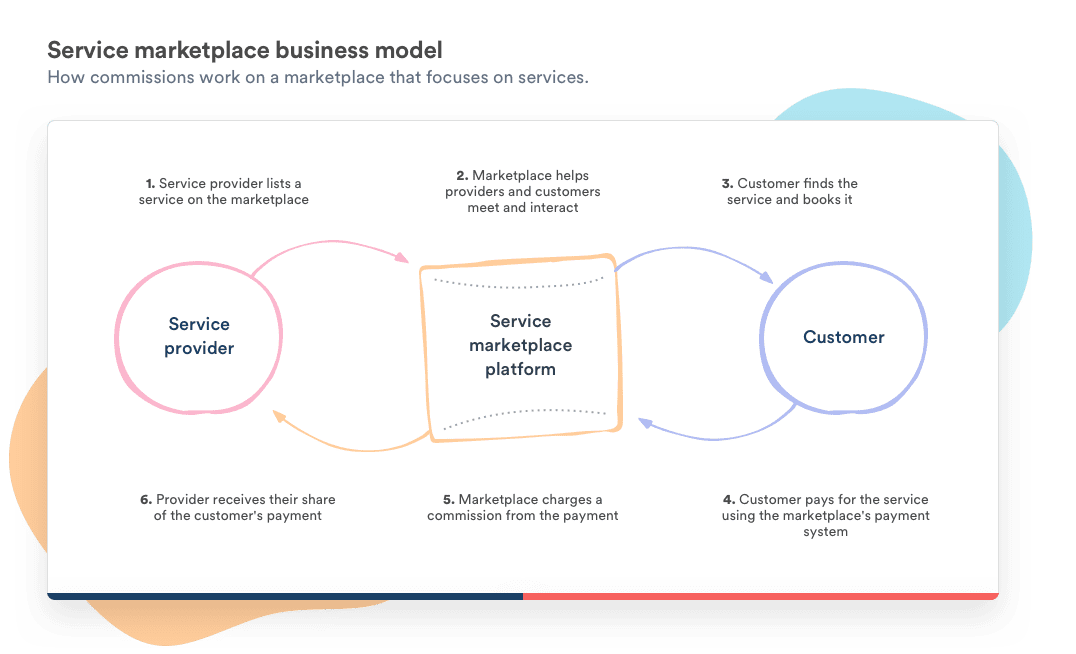
When we studied the business models of the top 100 marketplaces, we discovered that service marketplaces can succeed with a wide range of business models.
Many favor a combination of a commission fee and a subscription fee. Or add even further revenue streams, such as one-off services or lead fees, into the mix. (The category “Other” in the graph below mostly consists of platforms that use several revenue streams on top of commissions.)
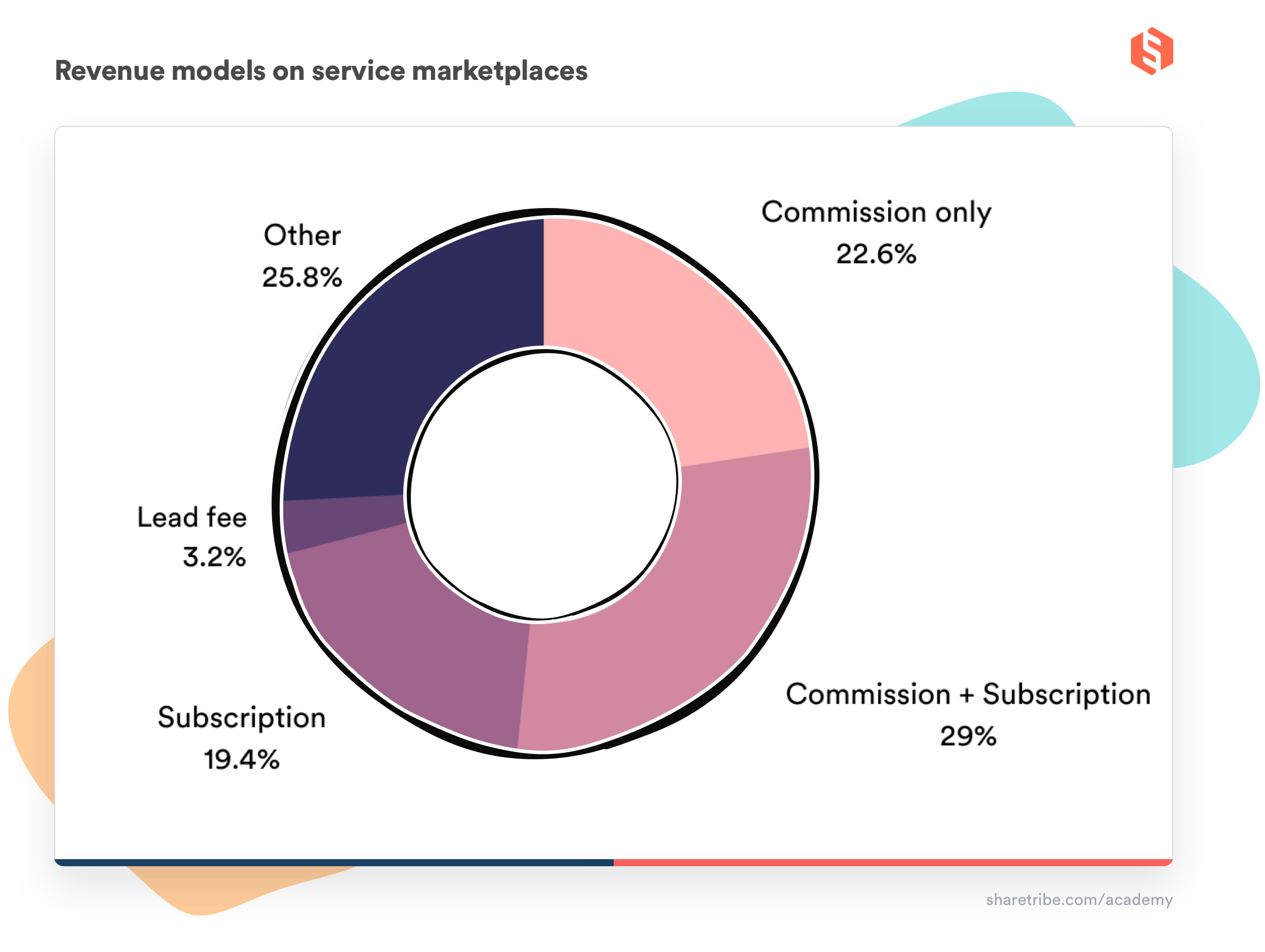
Commission is usually the fastest model to get your business off the ground because it’s frictionless. Service providers can sign up for free and only pay when they make money.
A subscription fee, a membership fee, or a listing fee can be a good strategy if your customers are so difficult to find that your service providers are ready to pay to access them. Or vice versa. Some marketplace platforms may also sell ads or additional services.
Typically, these strategies are most useful as additional revenue streams on top of commission. Most successful marketplaces start off with commissions only and add new revenue streams as the business matures.
Thanks to marketplace software, developing a marketplace website has become easier than ever before.
But building a platform isn’t the hardest thing a marketplace entrepreneur faces. The biggest challenge is solving a real problem for two very different user groups: customers and service providers.
Here’s a process we’ve seen work again and again for marketplace founders. We’ll discuss the steps in more detail and link to further reading on each.
- Find and validate your marketplace idea
- Choose your business model
- Build an MVP of your marketplace website (including the essential service marketplace features)
- Build a user base
- Track and grow your business
- Build, learn, and improve
Successful service marketplaces solve a real problem for both user groups extremely well.
To compete for the vast opportunities in the industry, your idea should achieve what Thumbtack did: make buying and selling services a lot faster, easier, and cheaper than it previously was.
Try to spot marketplace ideas by analyzing the services you encounter at work or in your free time. Look for:
- Inefficiencies
- Underused assets
- Fragmented markets
- Services where you can add a layer of trust
Here are some questions to inspire you:
- Does it take ages for you to find a repairperson for a specific task?
- Is comparing office maintenance providers and asking for quotes so time-consuming that you just use the one you always have, even if you’re not happy with the cost or quality of the service?
- Would you be willing to pay someone to set up a Google Ads campaign, but find hiring and briefing a stranger too much of a hassle?
When you encounter a hurdle like this, stop and think about how a services marketplace could make the experience smoother.
It’s possible that someone else has come up with the same idea as you have. But don’t shy away from the competition immediately.
For example, there are many freelance marketplaces and micro-jobs websites around. But that doesn’t mean you shouldn’t build a website like Fiverr, Upwork, or Thumbtack.
A smaller player can win against the giants by focusing on a small niche. FreeUp used this strategy to build a successful marketplace for hiring freelancers for online businesses. (Investor Fabrice Grinda believes this verticalization is a big trend for marketplaces.)
You could also analyze what people list on generic platforms that aren’t optimized for services. Are lots of professionals trying to offer certain services on Facebook Marketplace?
That might mean an opportunity for a service marketplace to improve the experience.
Have an idea in mind? Before building anything, validate your marketplace idea by talking to potential users.
Try to understand your assumptions about their problems and how well your marketplace idea can solve them. And, importantly: are they willing to pay for the solution your marketplace offers?
Choosing the right business model depends on your target market and service type. We recommend starting with a simple commission model to reduce friction. As your marketplace grows, you can layer in subscriptions, featured listings, or premium services to offer more flexibility to your user base.
It’s difficult to predict how people will behave.
Your website might offer a specific service a lot cheaper than existing solutions. But is that enough to bring users in? Will they actually make the first transaction? And will they come back and use your marketplace again and again?
The best way to get answers to these questions is to launch your marketplace as quickly as possible.
That way, you can start learning from real users and making real revenue early. The lessons you learn will give you an enormous competitive advantage.
The first version of the service platform you launch doesn’t need to be perfect. In fact, we always recommend starting with building a Minimum Viable Product (MVP).
The MVP version of your marketplace should have the core service marketplace functionality that makes your users love using your website.
But nothing more.
Anything that isn’t essential is a waste of time and money in the beginning. You should use these resources to market your platform, learn from your users, and build your business.
There are many ways to develop a marketplace website. Sharetribe’s no-code marketplace builder is the fastest way to get started, and you can expand your marketplace indefinitely with custom coding.
If you have some development skills and want to spend more time, it’s possible to set up a marketplace with a website builder like WordPress. With even more time and skill, you can develop a marketplace app from scratch.
However, consider carefully how much time you invest in building a platform. If you haven’t validated your idea before launching, a lot of your work might go to waste.
Next, let’s look at the building blocks of a service marketplace MVP. (Pro tip: If you’re using Sharetribe, all these features are included out of the box.)
Users expect marketplace platforms to work in a certain way. And online service marketplaces are particularly vulnerable to platform leakage. That’s where the customer and service provider use your marketplace to find each other, but then make the payment outside of your system.
The temptation to do that is much lower if your marketplace features provide a lot of value. Here are the key features your service marketplace needs to ensure users transact on the platform.
 User accounts and profiles
User accounts and profiles
Profiles are particularly important for service marketplaces.
First of all, they’re a tool for service providers to build their professional brand.
They also help you build trust between users with details like profile photos, background information, certificates, testimonials, and reviews. You could also add a user verification feature to your profiles.
Your marketplace should let customers and service providers create an account, log in to your marketplace, and store their user information securely. Both the providers and the customers usually first create a user profile before they do anything else.
 Listings and search
Listings and search
The type of services your platform offers determines the kind of listing features you need.
No matter your marketplace niche, the service providers will want sufficient tools to showcase and market their offerings. Users should have powerful tools to browse, search, and filter listings based on their criteria.
The listing and search functionality is complicated to build, so consider carefully what is essential for your MVP. This article on designing your marketplace search and discovery can be helpful.
 Availability and booking management
Availability and booking management
Availability and booking management is a crucial feature. It lets service providers set their working hours, block out unavailable times, and avoid double bookings, saving them time and reducing administrative work.
There are three main booking flows to consider:
- On-demand bookings are for services that need immediate fulfillment, like ridesharing or home repairs. Availability is shown in real time, and bookings are often accepted instantly.
- Scheduled bookings are better for services with scheduled appointments, like fitness classes, tutoring, or beauty treatments. Providers manage a calendar, and customers book specific time slots.
- Reverse marketplace flows are used when customers post a job and providers apply to fulfill it. This model works well for services like freelance projects or larger home improvement jobs where scope and pricing vary.
Choosing the right booking flow is crucial for user experience. Some marketplaces offer a mix of different booking flows, depending on the service or user type.
A strong booking system also helps you prevent platform leakage. Give your providers great booking management tools, and the trouble of circumventing your platform won’t be worth it.
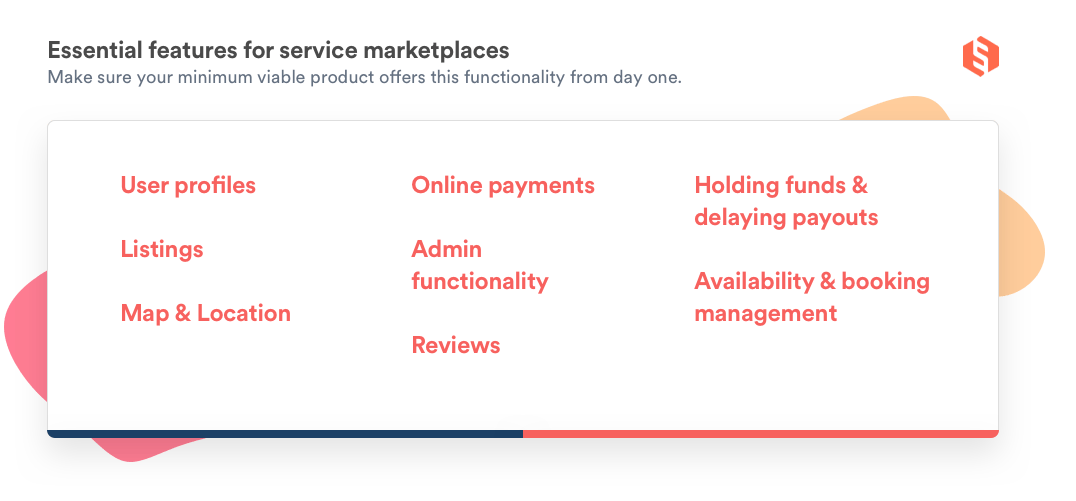
 Online payments
Online payments
Most marketplaces make money by charging a commission. This requires an elaborate marketplace payment system.
First, your marketplace needs to let customers pay with their desired payment method.
Then, you need to pay that money to the right provider, but only after you have deducted your commission. There are all kinds of legal and regulatory requirements to take into account here.
If you’re not using marketplace software with a pre-built payment infrastructure, we recommend integrating with a marketplace payment service provider, like Stripe Connect.
 Holding funds and delaying payouts
Holding funds and delaying payouts
To add a layer of security, almost all marketplaces have a service called escrow.
Escrow means a customer’s payment method is already charged when they book a service. The platform holds the payment until the service has been delivered and then pays the provider. This arrangement protects both parties from fraudulent users.
 Reviews
Reviews
After a successful transaction, the service provider and the customer review each other. Often, the reviews are blind: a seller only sees their review after they’ve submitted theirs on the customer.
Double-sided reviews build trust between users. They also help your service professionals build their brand. And might help you prevent leakage too: a provider might see more value in adding a new review to their profile than in avoiding your commission.
 Admin functionality
Admin functionality
The service marketplace founder needs full control over the platform. Typically, that means you need a dashboard where you monitor and access all user profiles, transactions, messages, and reviews.
Monitoring your users’ behavior can give you extremely useful insights, particularly in the early days.
To maintain trust, you also need to moderate content, block users, and edit payments when necessary.
 Map and location search
Map and location search
If your marketplace deals with local services like babysitters or photographers, you need a map and location feature. Providers tag their listings on a map, and customers can search for listings based on location.
If your marketplace only focuses on digital or remote services, a map isn’t necessary.
After your service marketplace MVP is ready, it’s time to launch it to your audience.
Or audiences, to be precise. Marketplaces serve two very different user groups: service providers and customers.
Often, the best way to start building your user base is by bringing the service providers in first.
Bringing in high-quality service providers early on helps you overcome the classic chicken-and-egg problem. Providers are often easier to onboard initially, especially when your marketplace offers tools that simplify their business operations, like streamlined booking, payments, and customer management. Without a strong supply base, it’s much harder to attract demand.
To make joining your platform a no-brainer for providers, offer incentives like:
- Fee holidays: Waive commission fees for the first few months after a provider joins your marketplace. This gives providers time to experience the value of your platform before paying.
- Verified pro badges: Offer early providers a “verified” badge that highlights their credibility and experience. Profile verification builds trust with customers and helps providers stand out in search results.
- First-job bonuses: Reward providers with a cash bonus after they complete their first successful booking through your platform. This type of financial incentive encourages quick engagement and helps providers get over the initial activation hurdle.
- Helpful SaaS tools: Include professional tools for managing bookings, availability, and payments. When your platform improves their workflow, providers are more likely to join and stay active on your marketplace. For example, Fresha started as a free booking tool for beauty service providers before it became a marketplace.
Once you’ve seeded your marketplace with high-quality supply, you can do a marketing launch to customers. If you’ve validated your idea well, you already have some ideas on where to find them. Recruit your service providers to help your launch by spreading the word among their existing clientele. Some additional proven channels to find your first customers include:
- Facebook groups in your niche or local area
- Local classifieds like Craigslist or Gumtree
- Niche forums and online or local communities relevant to your services
For more expert tips on getting service providers to join your platform, check out our guide on how to onboard and grow your initial supply.
You now have a group of early users on your service marketplace. Now let’s track their behavior.
Start with our detailed guide to key marketplace metrics. They might be different from what you think.
For example, it’s quite natural to get a boost of dopamine from seeing your user count go up. But volume isn’t the only thing you should focus on in the early days, or even the most important thing.
Instead, focus on reaching liquidity. Liquidity means the likelihood of a seller making a sale on your marketplace and a buyer finding what they’re looking for.
If you ask any marketplace expert, investor, or founder, it’s the North Star metric for any marketplace. So, focus first on reaching liquidity with your small initial user base.
Liquidity is measured by your sell-through rate (the share of listings sold within a certain time) and purchase rate (the share of visits that lead to a sale).
Here are some other marketplace metrics to track early on:
- Gross merchandise volume (GMV): The total value of transactions happening on your marketplace
- User base growth: The increase in the number of active providers and customers over time
- Transaction volume: The total number of completed bookings or service transactions
- Repeat purchase rate: How often customers return to book services again, which is a key signal of marketplace stickiness
- GMV retention: How much of your GMV value you’re able to keep every month
- Unit economics: Specifically, the ratio between your CAC (customer acquisition cost) and CLV (customer lifetime value)
As you grow, your metrics should also reflect your progress through two critical stages. First, you need to reach problem-solution fit, or the early validation that your marketplace solves a real need for a specific user group. You’ll see clear signs like positive user feedback, regular transactions, and some natural word-of-mouth growth.
Then you need to find product-market fit, or the stage where your platform becomes the go-to solution for your market. You’ll see high liquidity, low churn, and sustained organic growth.
Then, you can start building a marketplace growth strategy that will allow you to scale into bigger markets.
Launching an MVP fast is the first step.
The second step comes when your marketplace starts growing. You look at how your users behave and interact, and where they hit bottlenecks in your platform. You learn what features your business needs to add to keep providing value and differentiating your brand from competitors.
One real-world example is Fresha. It started as a simple booking tool for salons and evolved into a thriving service marketplace by constantly listening to users, refining features, and layering in more value over time.
Here are some practical ways to keep learning and iterating:
- Run monthly surveys with your top 10% of users to gather feature requests and satisfaction feedback.
- A/B test key elements like pricing structures, search filters, or loyalty credit systems to see what drives more conversions.
- Send exit-intent polls to providers who churn, asking, “What would have kept you listing with us?” and offering a small reward, like a $10 gift card, for participation.
- Trigger in-app NPS surveys after users complete their third transaction to gather early indicators of satisfaction and retention.
The growth stage is also the right time to invest in custom-developing your platform.
You’ve validated your idea with real users. And you’ve heard real user feedback. You know your investment won’t be wasted.
So, build features you think can optimize conversion, boost customer lifetime, or prevent leakage. See what happens, then iterate.
And repeat. Win against competitors by investing your time and resources where your data tells you they count the most.

As you grow, you can also unlock additional monetization options:
- Premium listing boosts to help providers get more visibility
- Advanced features like analytics dashboards for top sellers to track performance
- Subscription tiers for “verified pros,” including premium tools like automated invoices or CRM features
- Loyalty programs or marketplace credits to incentivize repeat bookings and boost retention
We’ve developed Sharetribe exactly for this iterative process. Our no-code builder gives you all the essential features you need to launch fast, like listings, bookings, payments, and user management. You can have a service marketplace up and running in one day without writing a single line of code.
Once you’re ready to take your business to the next level, you can custom-develop unique features on top of your Sharetribe marketplace. And you can still keep all the no-code benefits like backend hosting, maintenance, security, backups, and updates.
This approach can save up to 90% of the time and cost of building a service marketplace.
But percentages are relative. Instead, let’s talk about concrete sums, the real costs of building a service marketplace.
Of course, the following are rough estimations and averages. We arrived at them by talking with various developers across our global developer network and examining how our customers use Sharetribe today.
Services marketplaces are complicated websites. Even the MVP version requires many features for both user groups, such as a powerful transaction engine and admin functionality.
Building such a site from scratch is time-consuming and expensive.
Developers' hourly fees vary, but typically, $50,000 is the minimum for a basic service marketplace feature set. Fees from hosting, third-party tools, maintenance, and updates are added on top.
If you’re comfortable with software programming, you could avoid some of these costs.
However, you should assign a monetary value to your own work. The most important resources founders have are their time and focus. Be sure to spend them where they offer the biggest return on investment.
(If you’re interested in exploring this option further, we recommend checking out our guide to developing a marketplace app by our senior full-stack developer, Mikko. It helps you estimate the scope of the project and choose your technology stack. Or if you’d like to compare different approaches, this article on different ways to develop a marketplace will be helpful.)
To compare, here’s a breakdown of two example budgets for the first year of using Sharetribe.
The first budget is for using Sharetribe’s hosted, no-code builder.
The second budget is for building a fully custom marketplace on top of Sharetribe and self-hosting the front-end application. You can also start with the first and move to the latter once you’re ready to scale.
Your service platform
| Sharetribe Pro plan for 12 months (annual billing) | $2,388 |
| Domain registration for 12 months | $10 |
| Logo design – free using a tool like Canva | $0 |
| Stock images – free using a service like Unsplash | $0 |
Marketing and user acquisition
| Blog and content marketing (Sharetribe's Pages feature) | $0 |
| MailChimp email marketing – free up to 500 contacts | $0 |
| Google Analytics – free version | $0 |
| Total first-year service marketplace budget with Sharetribe | $2,398 |
Note: On top of this budget, you might want to consider buying traffic in the form of Google Ads, for instance. However, getting a meaningful amount of traffic through paid advertising typically requires being prepared to spend at least $1,000 for relevant keywords per year.
Your service platform
| Sharetribe Extend plan for 12 months (annual billing) | $3,588 |
| Transaction fees for an average of 1,000 transactions per month (500 transactions are included in the plan) | $1,140 ($95/month) |
| UX design and wireframes | $1,500 |
| Custom development | $5,000 |
| Front-end hosting | $360 |
Marketing and user acquisition
| MailChimp Standard plan for up to 25,000 subscribers | $2,976 |
| Google Analytics – free version | $0 |
| Total first-year custom service marketplace budget on Sharetribe Extend plan | $14,564 |
At this stage, you know your market and customer lifetime value so well that you know where paid user acquisition makes sense. But these efforts should be net positive, meaning your customer acquisition cost is lower than customer lifetime value.
You can create your Sharetribe account and start a free trial here. If you don’t have a developer on your team, we’re happy to match you with a verified Expert developer. Learn more about custom development services for Sharetribe. Or check out our helpful guide on how to hire a marketplace developer for more advice!

Probuddy
Probuddy is a platform for booking private educational tutors and sports coaches.
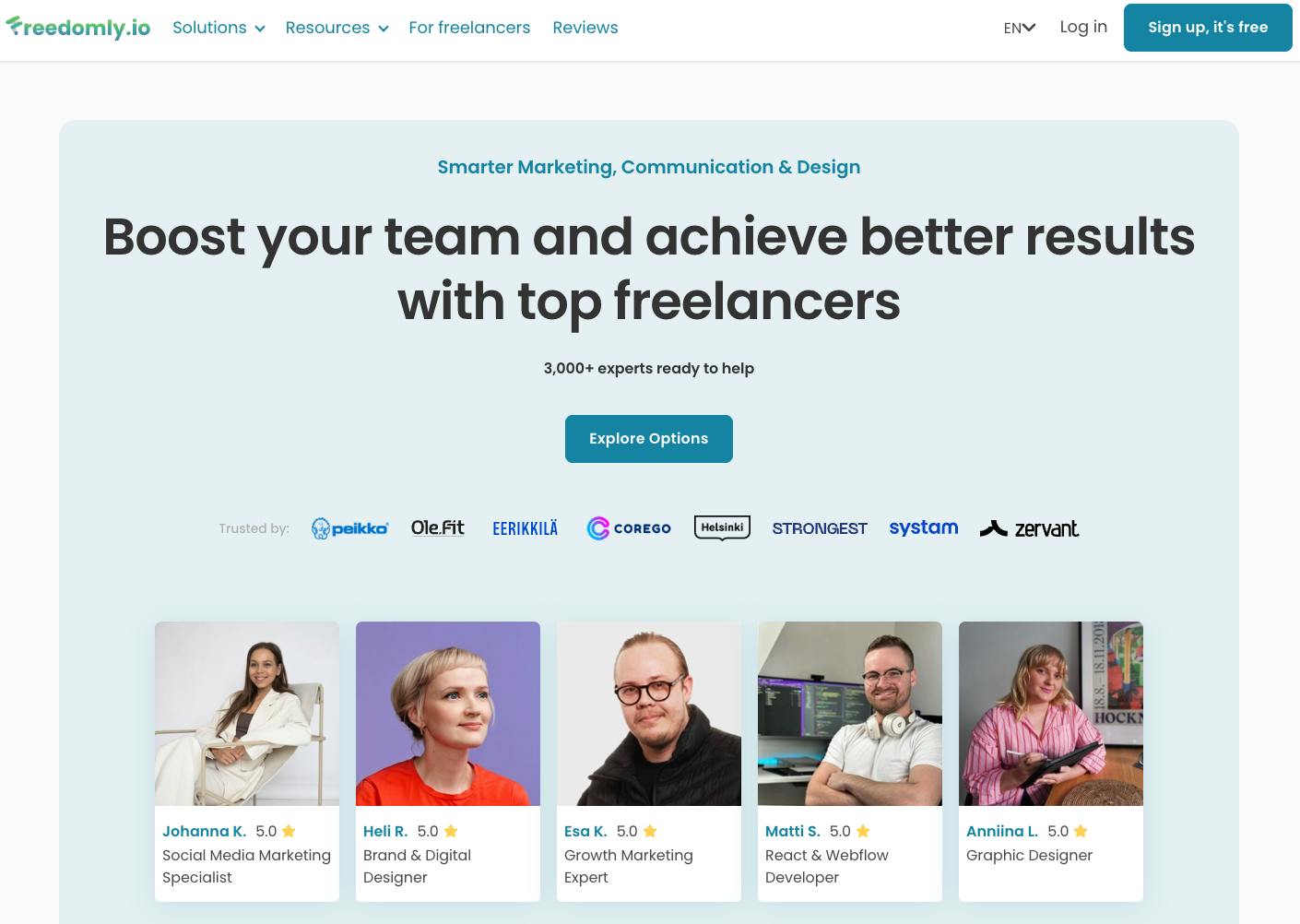
Freedomly
Freedomly is the #1 freelance solution in Finland.
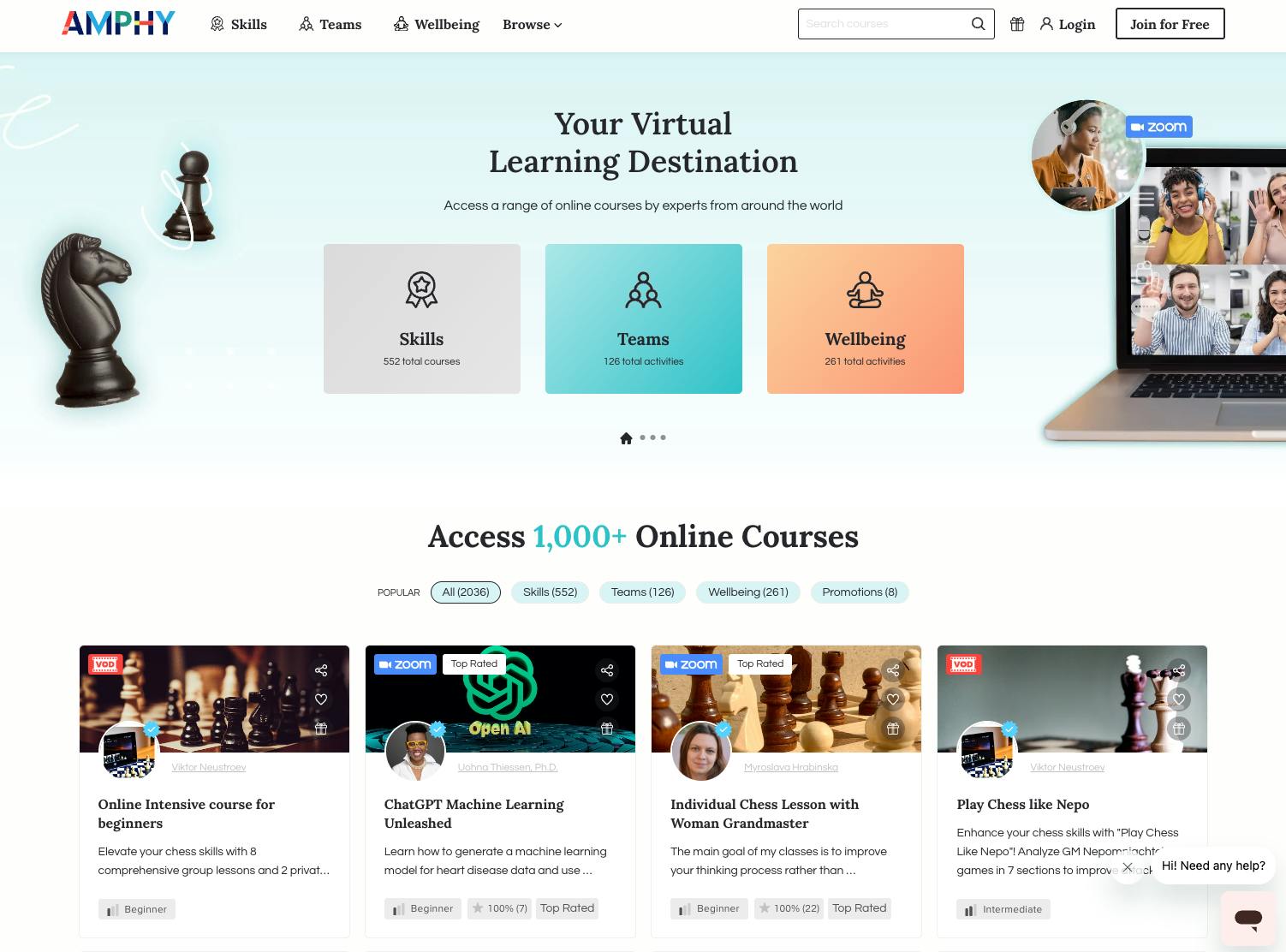
Amphy
Amphy is a marketplace for online learning.
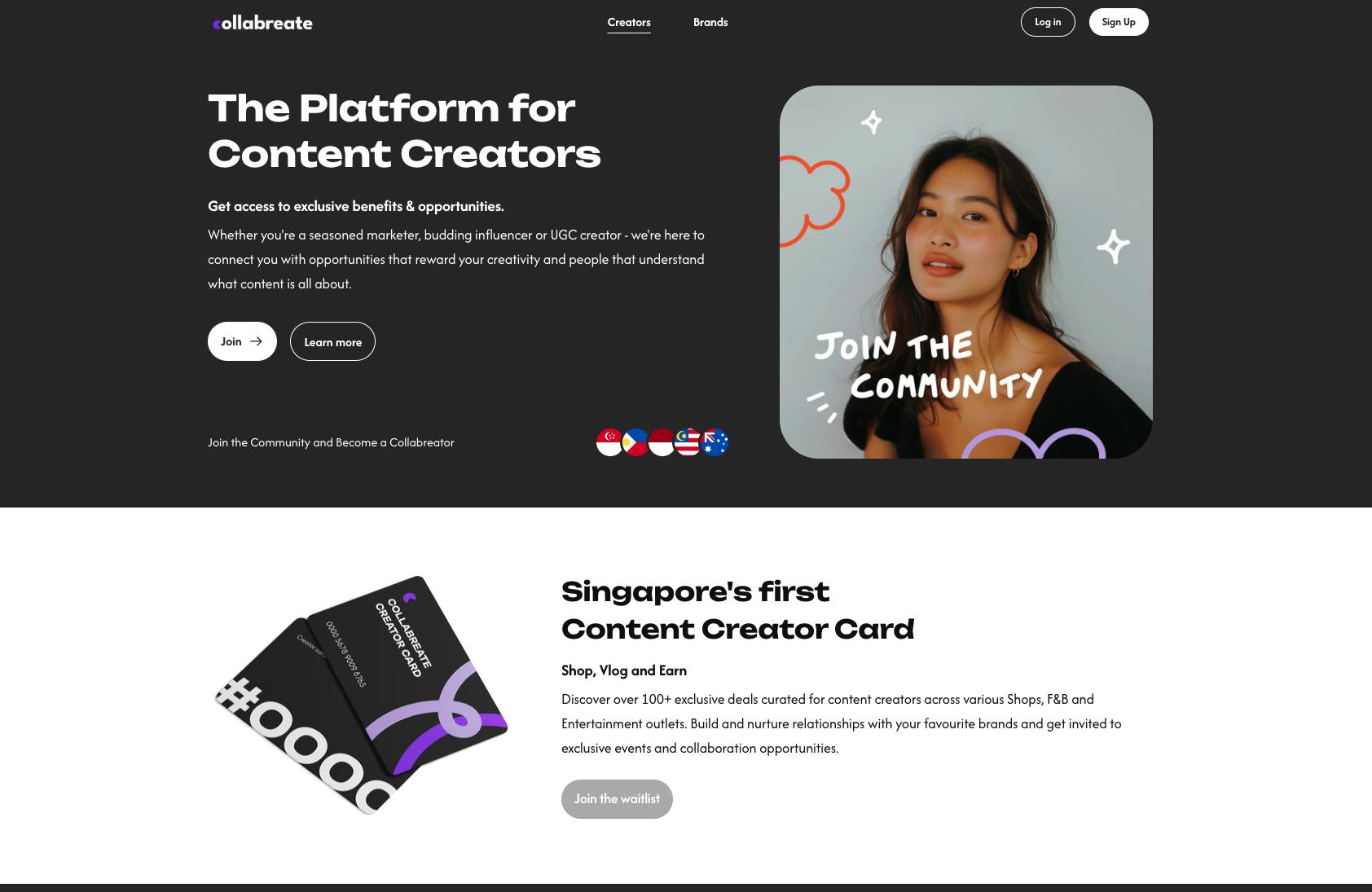
Collabreate
Collabreate connects businesses with remote freelancers and consultants for short-term projects and on-demand expertise.
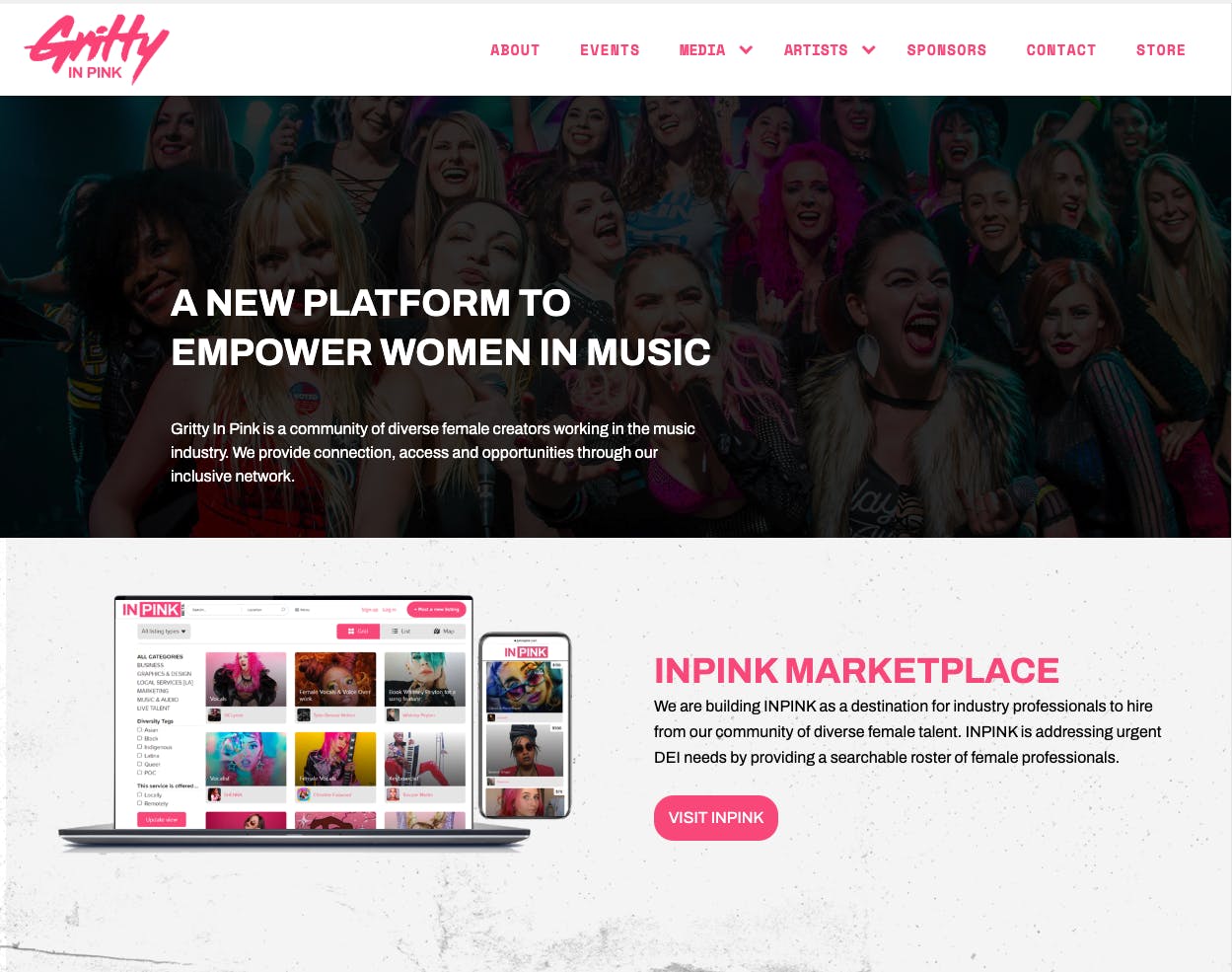
InPink
InPink is a service marketplace for booking live entertainment and creative professionals, focused on promoting women and underrepresented talent in the music and events industry.
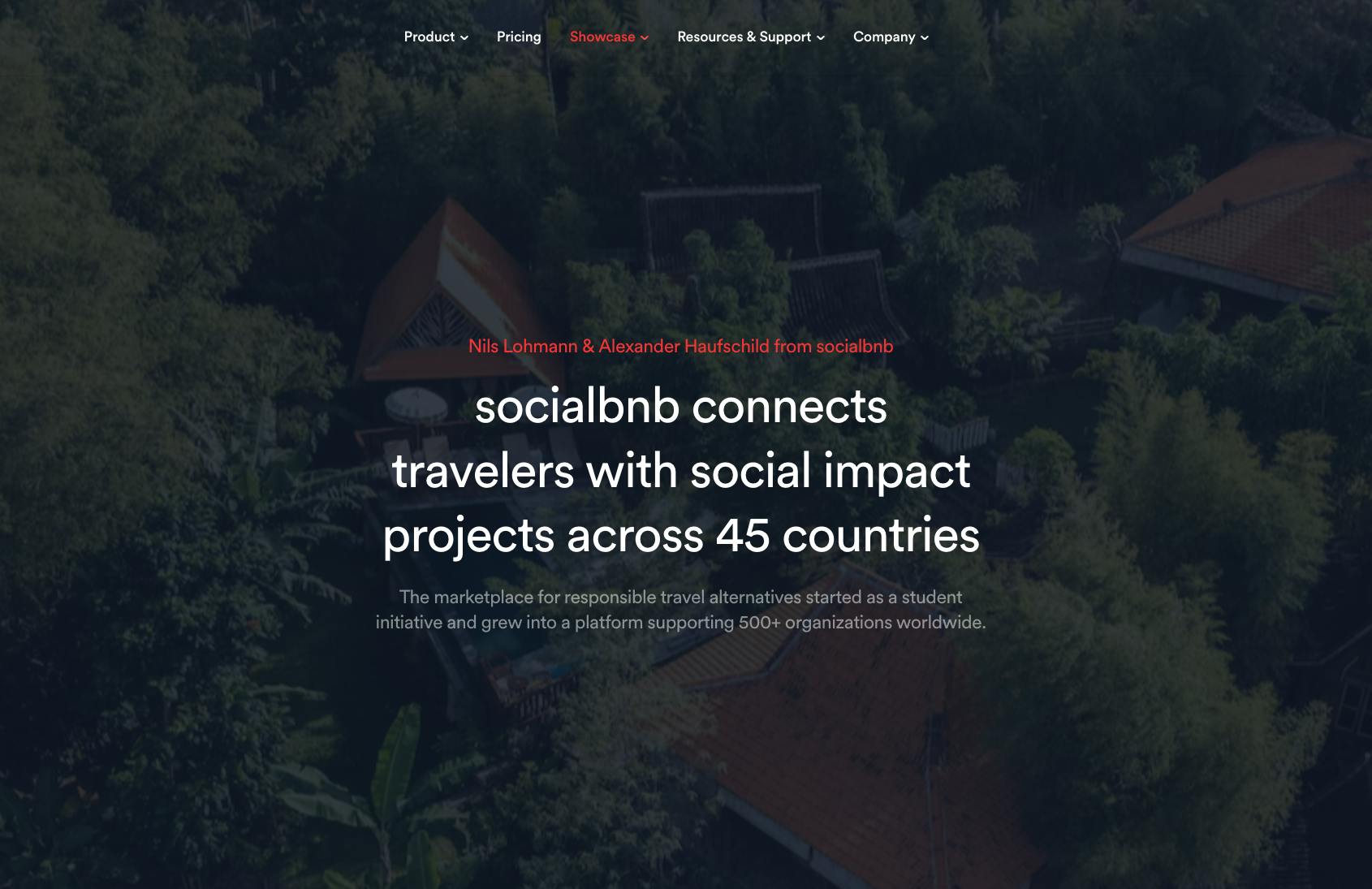
socialbnb
socialbnb is a travel marketplace where travelers can book unique accommodations hosted by social and environmental projects and help support local communities with every booking.
Building a service marketplace can sound like a daunting task. Today’s users are familiar and comfortable with e-commerce. At the same time, they expect a flawless customer experience.
Service marketplaces are complicated websites to build, and the business model can be tricky to master.
But don’t let the challenge discourage you. Take the iterative approach and move your business idea forward one step at a time. You’ll accumulate experience and understanding that give you a real competitive advantage.
If you’re interested in reading more, our guide to creating a marketplace is a great place to start working on your business step by step. It’s helpful whether you’re building your marketplace website with Sharetribe or not.
Best of luck with your service marketplace!
With no-code tools like Sharetribe, you can launch a basic service marketplace in just a few days. Building a fully custom platform typically takes several months and a much larger budget.
The fastest approach is to start with a minimum viable product (MVP), validate demand, and iterate from there.
At a minimum, your marketplace should probably include:
- User profiles and listings
- Search and filtering options
- Booking or request functionality
- Payment processing and basic admin tools
- Map and location search for in-person services
Avoid overbuilding and focus on enabling transactions as simply as possible.
Most service marketplaces charge between 10% and 25% per transaction. Your rate should reflect the value you provide, such as bookings, payment handling, and marketing.
Many marketplaces start at a lower fee to attract early providers, then increase or introduce premium tiers over time. You can also combine commissions with other models like subscriptions or ads.
Not necessarily. Many successful marketplaces operate entirely through a responsive website. You only need a native app if mobile-specific features, like location-based on-demand services or push notifications, are critical to your user experience. Starting web-first reduces costs and speeds up time to launch.
The best way to prevent platform leakage is by offering providers valuable tools they wouldn’t get from direct bookings:
- Simple booking and payment systems
- Reliable customer acquisition
- Features like verified profiles, reviews, and dispute resolution
Providers will have little incentive to go off-platform if your platform makes business operations easier.
Start your 14-day free trial
Create a marketplace today!
- Launch quickly, without coding
- Extend infinitely
- Scale to any size
No credit card required
